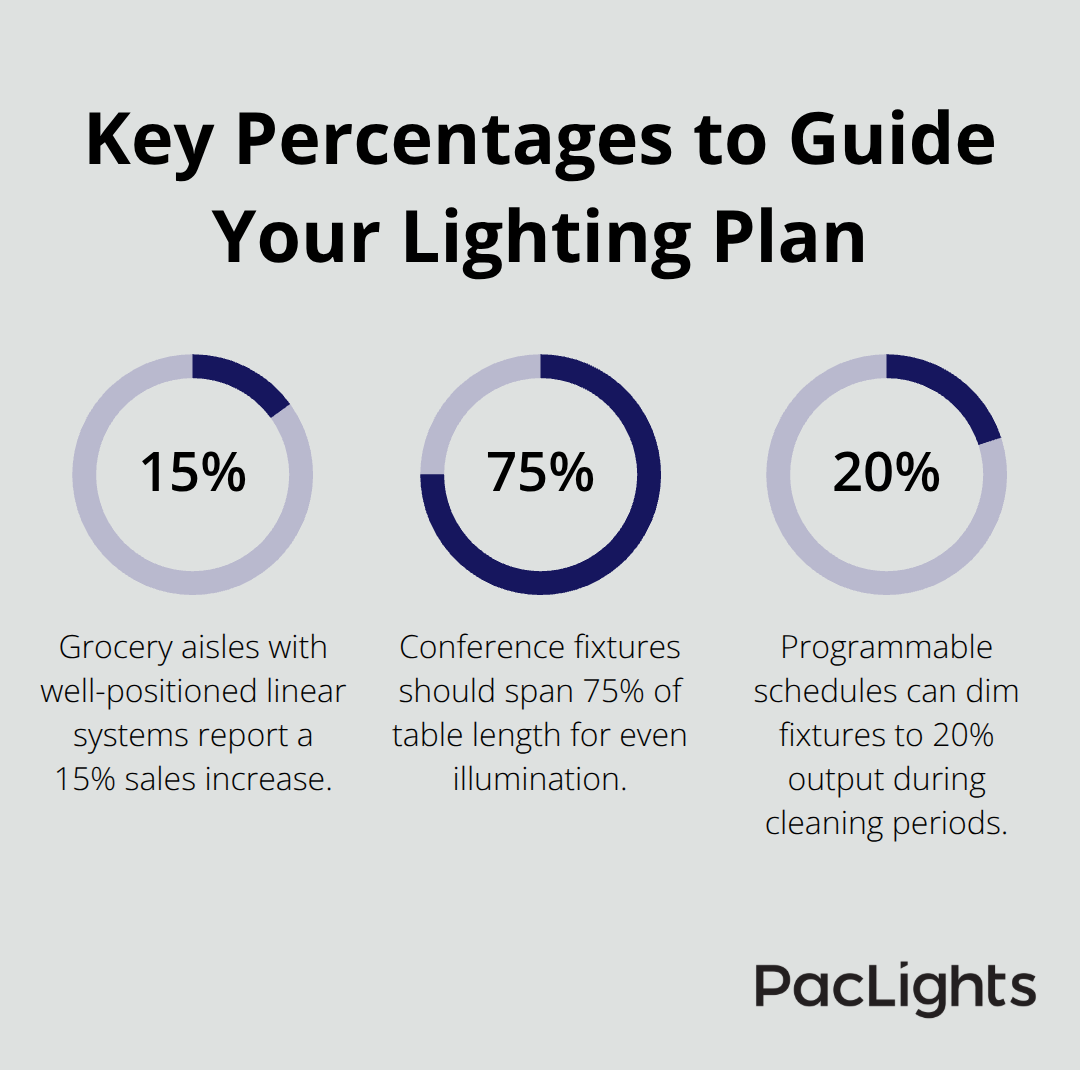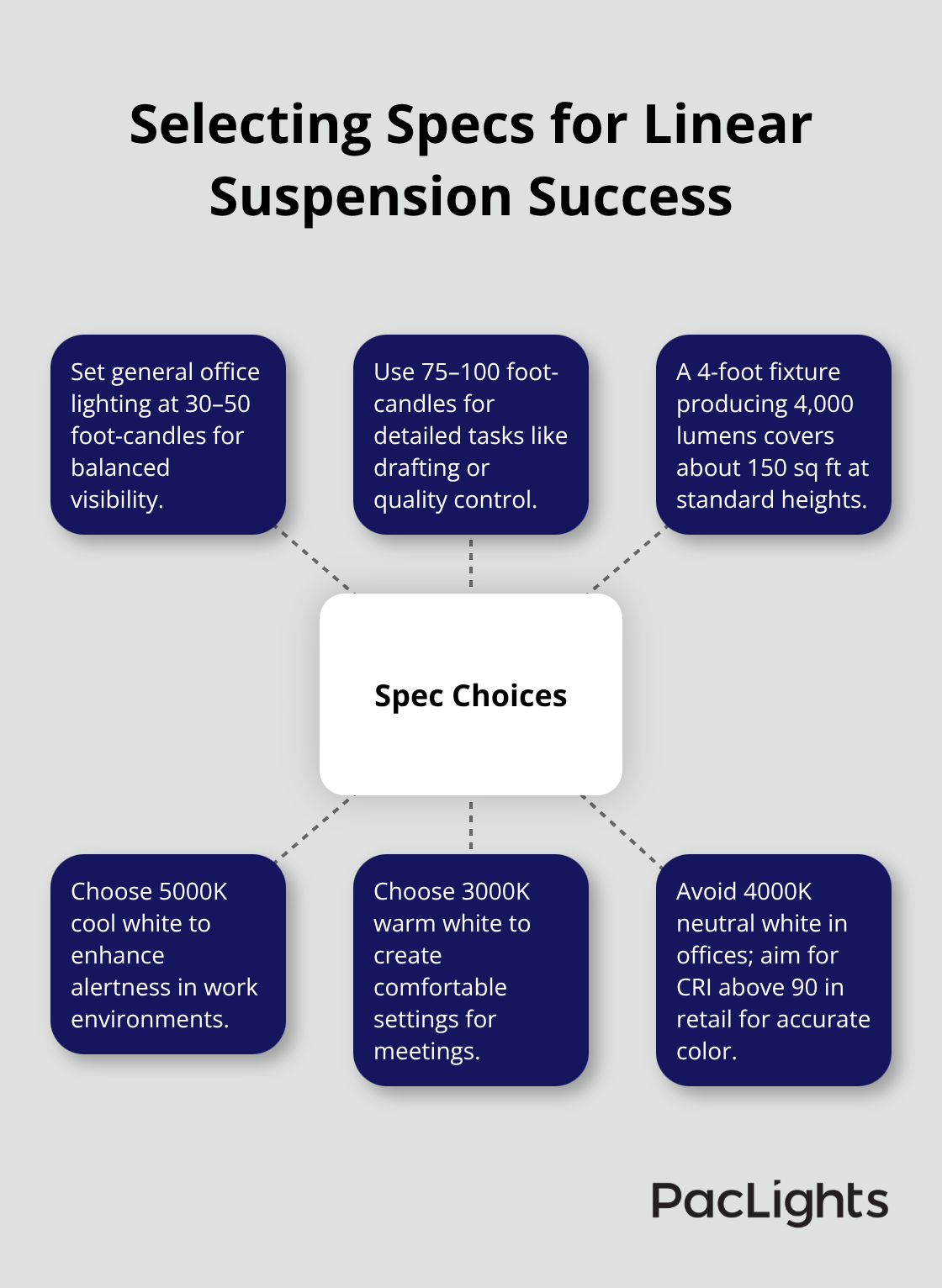Linear suspension lighting transforms commercial and industrial spaces with sleek, contemporary design that delivers both form and function. These fixtures provide exceptional illumination while creating striking visual impact.
We at PacLights see growing demand for lighting solutions that combine energy efficiency with modern aesthetics. Linear suspension systems offer the perfect balance of performance and style for today’s workspaces.
Why Linear Suspension Lighting Delivers Superior Results
Contemporary Design Creates Immediate Visual Impact
Linear suspension fixtures establish strong visual presence through their sleek, geometric profiles that align with modern architectural trends. The elongated form factor creates powerful horizontal lines that make spaces appear larger and more organized. Recent commercial design studies show that linear lighting increases perceived ceiling height by 15-20% compared to traditional pendant fixtures. These systems excel in open-plan offices where they define work zones without physical barriers. The clean aesthetic eliminates visual clutter while providing sophisticated illumination that impresses clients and motivates employees.
Superior Light Distribution Eliminates Coverage Problems
Linear suspension systems deliver exceptional light coverage compared to point-source fixtures, reducing shadows and creating uniform illumination across work surfaces. A single 8-foot linear fixture effectively lights a 12×20 foot conference room, while traditional chandeliers require multiple units for equivalent coverage. The wide beam spread eliminates dark spots that cause eye strain and productivity loss. Task lighting performance improves dramatically with linear systems positioned 30-36 inches above work surfaces (providing optimal illumination for detailed work). LED linear fixtures typically produce 130-150 lumens per watt, significantly outperforming fluorescent alternatives while maintaining consistent color temperature throughout their 50,000+ hour lifespan.

Energy and Maintenance Savings Drive ROI
LED linear suspension systems reduce energy consumption by 60-75% compared to fluorescent fixtures while delivering superior light quality. Commercial facilities that switch to linear LED systems report average annual savings of $2,400 per 10,000 square feet of illuminated space. The extended lifespan of LED components reduces maintenance costs through elimination of frequent bulb replacements that disrupt operations. Smart controls and dimming capabilities further optimize energy use (automatically adjusting output based on occupancy and daylight availability). These features typically reduce overall lighting costs by an additional 20-30% beyond base LED efficiency gains.
The versatility of linear suspension systems makes them suitable for diverse commercial applications, each with specific installation requirements and performance considerations.
Where Linear Suspension Fixtures Work Best
Open Office Environments Demand Strategic Placement
Office spaces need linear suspension fixtures mounted 8-10 feet above floor level to provide adequate task illumination without glare on computer screens. Place fixtures perpendicular to workstation rows to minimize shadows on keyboards and documents. Conference rooms benefit from fixtures that span 75% of table length, which creates even illumination for presentations and video calls. A 12-foot conference table requires a minimum 9-foot linear fixture to eliminate dark zones at table ends. Install fixtures 30 inches above conference tables to prevent obstruction of sight lines between participants. Dimming controls become essential in multi-purpose spaces where illumination needs shift between focused work sessions and collaborative meetings.
Retail Spaces Maximize Customer Experience
Retail environments use linear suspension systems to highlight merchandise displays and create inviting customer pathways. Mount fixtures 12-14 feet high in retail spaces to provide broad coverage while maintaining visual appeal.

Grocery stores report 15% increased sales in aisles with properly positioned linear systems compared to traditional fluorescent fixtures. The even light distribution eliminates harsh shadows that can make products appear less attractive to shoppers. Clothing retailers position linear fixtures parallel to display racks to showcase fabric textures and colors accurately (particularly important for fashion merchandise where color rendering affects purchase decisions).
Industrial Applications Require Robust Performance
Warehouse facilities need robust fixtures capable of withstanding temperature fluctuations and dust exposure. Industrial linear systems must deliver minimum 50 foot-candles at floor level for safety compliance in manufacturing areas. Position fixtures parallel to conveyor systems and assembly lines to eliminate shadows that compromise quality control. Warehouses exceeding 25-foot ceiling heights need high-output fixtures that produce 20,000+ lumens to maintain adequate illumination at ground level. Manufacturing facilities benefit from fixtures with impact-resistant housings that protect against equipment vibration and accidental contact.
The success of linear suspension systems depends heavily on selecting fixtures with appropriate specifications for your specific space requirements and operational demands.
How Do You Select the Perfect Linear Suspension System?
Fixture Dimensions Must Match Your Space Requirements
Calculate fixture length based on the 75% rule for optimal coverage. A 20-foot conference room needs a 15-foot linear fixture to provide even illumination without dark zones at room edges. Ceiling height determines suspension length requirements. Spaces with 9-foot ceilings need fixtures mounted 7-8 feet above floor level, while 12-foot ceilings allow 10-foot heights for better light distribution.
Width selection affects light spread patterns. Narrow 4-inch fixtures work well for accent applications, while 8-inch wide systems provide broader coverage for task areas. Multiple parallel fixtures spaced 8-10 feet apart eliminate shadows in large open spaces better than single oversized units.
Light Output and Color Temperature Drive Performance Results
Target 30-50 foot-candles for general office work and 75-100 foot-candles for detailed tasks like drafting or quality control. A 4-foot linear fixture that produces 4,000 lumens covers approximately 150 square feet at standard heights. Color temperature selection affects productivity and comfort levels significantly.
Cool white 5000K LEDs increase alertness in work environments, while 3000K warm white creates comfortable spaces for meetings. Avoid 4000K neutral white in offices (studies from the Lighting Research Center show it provides neither productivity benefits of cool light nor comfort advantages of warm light). High CRI ratings above 90 become essential in retail environments where accurate color representation affects customer decisions.

Smart Controls Maximize Energy Savings and Flexibility
Occupancy sensors reduce energy consumption by 25-35% in spaces with irregular use patterns like conference rooms and break areas. Daylight systems automatically adjust output based on natural light levels and deliver additional 15-20% energy savings in perimeter zones with windows.
Wireless controls eliminate expensive conduit runs and allow easy reconfiguration when office layouts change. Programmable schedules reduce after-hours energy waste by automatically dimming fixtures to 20% output during periods when staff clean facilities and turn off completely during unoccupied hours.
Final Thoughts
Linear suspension lighting transforms commercial and industrial environments with measurable advantages that facilities can track and verify. Energy savings of 60-75% compared to fluorescent systems create substantial cost reductions while improving light quality across all applications. The superior coverage eliminates shadows and dark zones that compromise productivity and safety in work environments.
Successful implementation requires careful attention to fixture dimensions, mounting heights, and light output specifications. The 75% rule for fixture length and proper ceiling clearances prevent common installation mistakes that reduce performance significantly. Color temperature selection between 3000K and 5000K optimizes comfort and productivity for specific applications (with cool white increasing alertness and warm white creating comfortable meeting spaces).
Smart controls with occupancy sensors and daylight harvesting maximize energy savings beyond base LED efficiency gains. These features typically reduce total lighting costs by an additional 20-30% through automated operation that responds to actual usage patterns. We at PacLights provide comprehensive lighting solutions that help facilities make informed upgrade decisions with measurable results.


Disclaimer: PacLights is not responsible for any actions taken based on the suggestions and information provided in this article, and readers should consult local building and electrical codes for proper guidance.